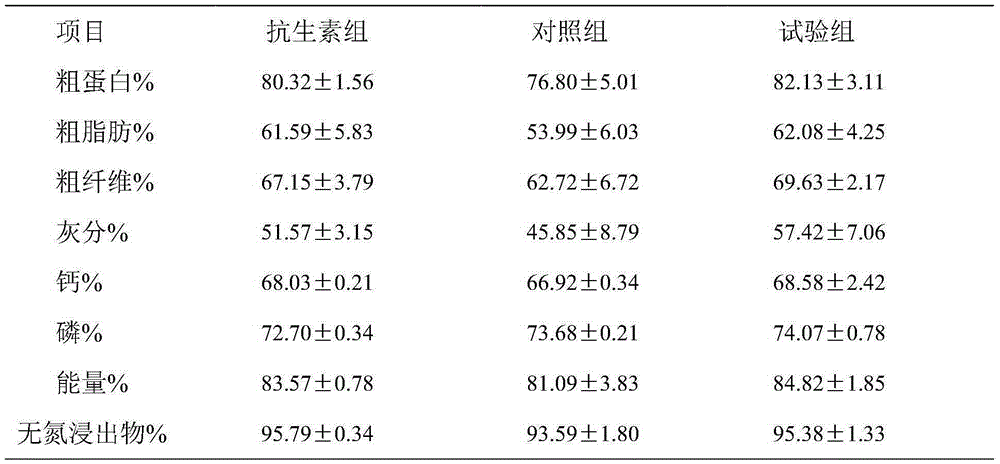Preparation method of feed micro-ecologic agent produced by using citrus peels
A micro-ecological preparation, citrus peel technology, applied in the field of feed industry and animal husbandry, can solve the problems of resource waste, animal feed bitterness, environmental pollution, etc., to save pollution control costs, create economic benefits, and improve competitiveness. Effect
- Summary
- Abstract
- Description
- Claims
- Application Information
AI Technical Summary
Problems solved by technology
Method used
Image
Examples
Embodiment 1
[0019] 1) Inoculate Lactobacillus delbrueckii (preservation number CCTCCM207096), Bacillus subtilis (preservation number CCTCCM207097), mirabilis (preservation number CCTCCM207098) into 100ml MRS liquid medium, 100ml broth liquid medium, 100ml potato dextrose liquid medium respectively , cultured at a constant temperature of 37°C for 24 hours to obtain a seed solution;
[0020] 2) Air-dried 100 parts of citrus peel, 10 parts of brewer's grains, 15 parts of wheat bran, 3 parts of glucose, 8 parts of soybean meal, 2 parts of urea, 2 parts of ammonium sulfate, 0.2 parts of potassium dihydrogen phosphate, 0.3 parts of magnesium sulfate according to weight ratio Parts were crushed separately, passed through a 40-mesh sieve, mixed evenly, added 100 parts of distilled water, mixed thoroughly, sterilized at 121°C for 15 minutes, cooled to room temperature for later use, and obtained a solid medium;
[0021] 3) Mix the three seed liquids prepared above at a volume ratio of 1:1:1, add t...
Embodiment 2
[0025] 1) Inoculate Lactobacillus delbrueckii (preservation number CCTCCM207096), Bacillus subtilis (preservation number CCTCCM207097), mirabilis (preservation number CCTCCM207098) into 100ml MRS liquid medium, 100ml broth liquid medium, 100ml potato dextrose liquid medium respectively , cultured at a constant temperature of 30°C for 21 hours to obtain a seed solution;
[0026] 2) Air-dried 100 parts of citrus peel, 12 parts of brewer's grains, 17 parts of wheat bran, 4 parts of glucose, 9 parts of soybean meal, 2.5 parts of urea, 2.5 parts of ammonium sulfate, 0.35 parts of potassium dihydrogen phosphate, and 0.35 parts of magnesium sulfate according to the weight ratio. Parts were crushed separately, passed through a 40-mesh sieve, mixed evenly, added 110 parts of distilled water, mixed thoroughly, sterilized at 121°C for 30 minutes, cooled to room temperature for later use, and obtained a solid medium;
[0027] 3) Mix the three seed solutions prepared above at a volume rati...
Embodiment 3
[0031] 1) Inoculate Lactobacillus delbrueckii (preservation number CCTCCM207096), Bacillus subtilis (preservation number CCTCCM207097), mirabilis (preservation number CCTCCM207098) into 100ml MRS liquid medium, 100ml broth liquid medium, 100ml potato dextrose liquid medium respectively , cultured at a constant temperature of 34°C for 18 hours to obtain a seed solution;
[0032]2) Air-dried 100 parts of citrus peel, 15 parts of brewer's grains, 20 parts of wheat bran, 5 parts of glucose, 10 parts of soybean meal, 3 parts of urea, 3 parts of ammonium sulfate, 0.5 parts of potassium dihydrogen phosphate, 0.4 parts of magnesium sulfate according to the weight ratio Parts were crushed separately, passed through a 40-mesh sieve, mixed evenly, added 120 parts of distilled water, mixed thoroughly, sterilized at 121°C for 20 minutes, cooled to room temperature for later use, and obtained a solid medium;
[0033] 3) Mix the three seed solutions prepared above at a volume ratio of 2:1:2,...
PUM
 Login to View More
Login to View More Abstract
Description
Claims
Application Information
 Login to View More
Login to View More - Generate Ideas
- Intellectual Property
- Life Sciences
- Materials
- Tech Scout
- Unparalleled Data Quality
- Higher Quality Content
- 60% Fewer Hallucinations
Browse by: Latest US Patents, China's latest patents, Technical Efficacy Thesaurus, Application Domain, Technology Topic, Popular Technical Reports.
© 2025 PatSnap. All rights reserved.Legal|Privacy policy|Modern Slavery Act Transparency Statement|Sitemap|About US| Contact US: help@patsnap.com



